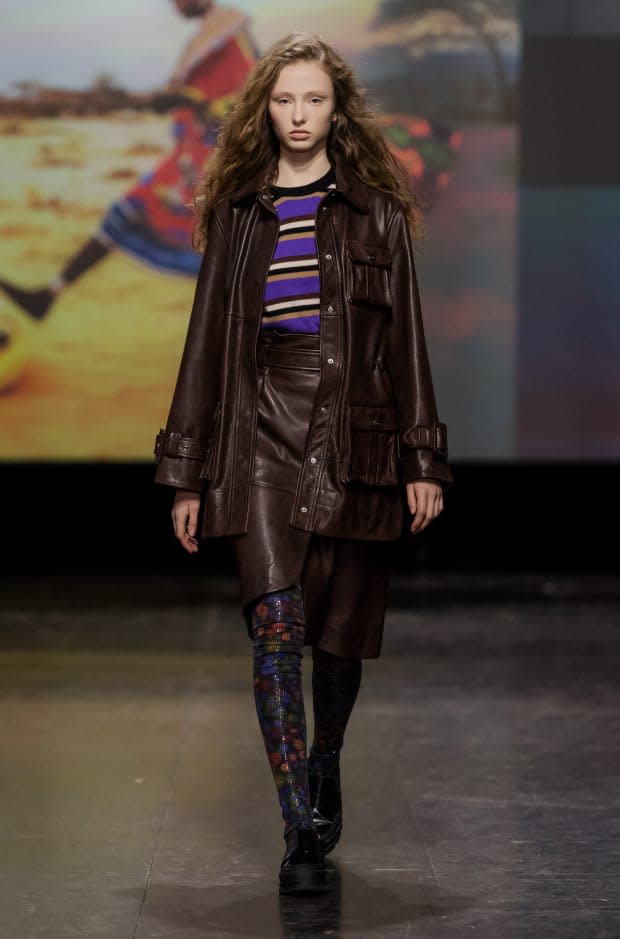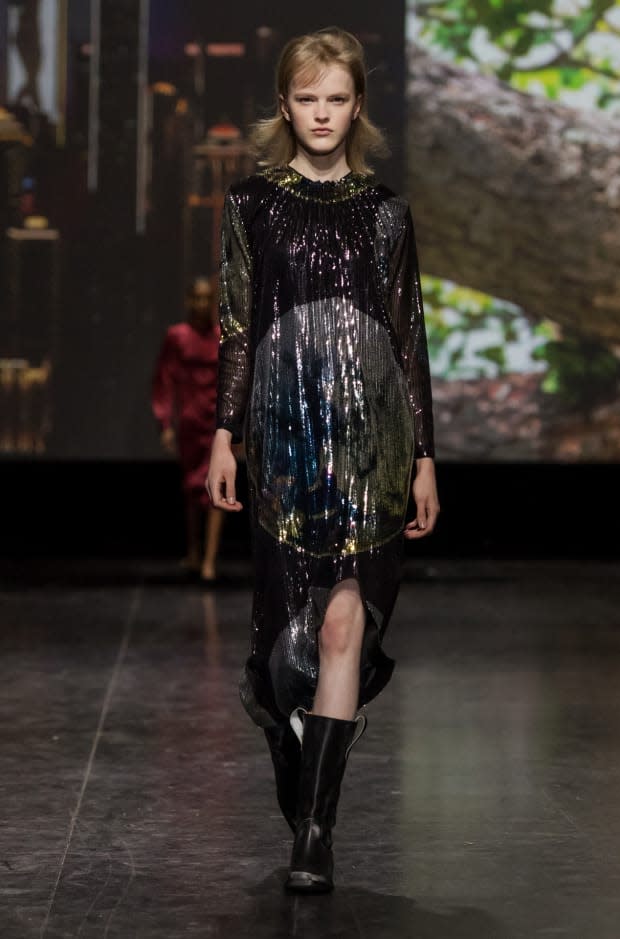What Was Really at the Core of Ganni's Now-Controversial Fall 2019 Show?
Titled "Life On Earth," the brand's use of Ami Vitale's photography as a runway backdrop is causing a stir.

Closing out Copenhagen Fashion Week, which is actually just a couple of marathon-days in duration, is arguably the buzziest show of the entire event: Ganni. That final night, press, influencers, artists and tastemakers — many of them dressed in the label — gathered at the show venue for the It-brand's Fall 2019 collection, titled "Life On Earth." Setting the scene were billboard-sized, bright screens displaying National Geographic imagery by photographer Ami Vitale, depicting wild animals, naturescapes and people from around the world, intended to depict all that planet Earth has to offer, centered around the idea of sustainability for our future and ode to the global "Ganni girl" (the tagline for anyone who shares themselves wearing the brand on social media).
The collection itself may have touched on these motifs, but not consistently in a way that was as overtly obvious as a glittery globe dress. The consensus was that it definitely took a closer look to see the supposed theme come to life (pun intended) at all in the collection, which at first glance featured many of Ganni's signature pieces and silhouettes, like menswear-inspired shirting, practical puffer outerwear, patterned silk dresses and chunky footwear. In honesty, it didn't look too distinguishable from the Ganni the fashion industry tends to know and love at this point in the brand's tenure.
But, what was more unclear was how or why Ganni was using images of underprivileged women in developing countries as a backdrop for a runway of mostly white models dressed in the brand's contemporary-priced clothing with little-to-no mention of how or why these images really served any true connection to the clothing or the mission of the brand at its core.

That has triggered a bit of backlash, specifically from Pakistani-American writer Anaa Saber, who attended the show as a self-proclaimed lover of the brand. She took to Instagram after the show to comment on her discomfort at the slideshow of images that served as the backdrop.
"The brand fetishized these women and used them as props and marketing tools. This was not a platform for these marginalized women to get representation… They are shown through the 'white' gaze, reduced only to their aesthetic value... My people are not your aesthetic," reads Saber's caption on Instagram, which received close to 3,000 likes and more than 250 comments, many from her fellow fashion industry insiders.
When Saber reached out to Ganni for comment on the issue, the brand responded via DM, stating, "We sourced hundreds [sic] of Ami's acclaimed photographs to be a part of the show set design… The images showcase all elements of nature from surreal beauty to the enduring power of the human spirit, capturing the energy of life on earth in all forms." But the explanation became even fuzzier when Ganni and Ami Vitale announced retail profits of tees and hoodies with similar imagery, sold at Ganni's Kiosk pop-up store in Copenhagen, would go to Conservation International, which works to protect nature and the planet.
"[Ganni] is displaying two decades of my work of this magnificent planet and all the humanity that we coexist with. It's a huge privilege to collaborate with a company like this because they're really taking massive steps to become more sustainable, and they understand that the planet and protecting what's left is really important," Vitale stated in the brand's Instagram stories on the evening of the show. But as Saber states in her comments section, "These humans are not endangered species."
Sustainability has been a repeated theme this week in Copenhagen, with Designers Remix accompanying their show of pieces made from recycled materials with a sustainability talk featuring Arizona Muse, Mother of Pearl's "No Frills" collection shown on day one, and newer brands like Carcel presenting a silk collection made in prisons. Inclusivity, though, hasn't necessarily been Copenhagen's strong suit, with a handful of shows lacking representation, or worse, using an entirely white cast of models, as was the case at Cecilie Bahnsen. And while Ganni attempted to touch on both issues at its highly anticipated close-out show, it may have gotten lost somewhere along the way.
In a time when words like sustainability and inclusivity are tossed around like salad dressing, the answer is pretty simple, really: Don't use them unless you have the reasoning to back them up. And while Ganni has boasted numerous sustainability-driven initiatives in recent years, it seems as though this particular package isn't sitting well everyone, despite the fact that many influencers and publications have yet to raise any concerns about the show, and both Vogue and Elle's reviews remaining generally positive.
The show notes attempted to contextualize the use of Vitale's images, noting that, "We've been working really hard to make Ganni more sustainable. I believe we are all capable of changing something, but we need to make it top of mind and create tangible solutions. [.... Vitale] has this approach to photography, that instead of depressing people with a cynical outlook, you can inspire them to take action by showing them the beauty of the world." But, it’s arguable that the images shown on-screen contrasted the show instead of providing context. We spoke to Saber to get her thoughts on Ganni's handling of the situation.
"According to their statement, these pictures were supposed to benefit the people in the pictures by bringing 'attention and engagement with their stories.' But did this message come through in the fashion show? I firmly believe not," Saber tells Fashionista. "These women remained anonymous; their great work, entrepreneurship, resilience and stories were not mentioned in any publicity material prior to the show or at any point during the show. The first time I heard their identities, their stories and the names and details of the organizations some of them run was through a conversation with Ami I had myself. In which she also apologizes for the misused context."
Neither Ganni nor Vitale have issued a public apology. "This needs to be addressed to the public not me, Ganni needs to apologize to their community and all the 'Ganni Girls' out there they have offended. This is a serious matter, a DM apology is unacceptable," Saber insists.
It's clear that Ganni didn't intend on this response, and it's not unanimous. But the conversations still need to be had, especially in the context of Copenhagen Fashion Week where the topics of diversity and inclusivity aren't quite as hot-button as they are in New York. For a brand on such a global stage as Ganni, it certainly could have been handled more empathetically, at the very least. Time will tell if this will have a lasting effect on the brand's popularity, but judging by the press and fans' mostly-positive response, we think it may be business as usual in this particular case.
Ganni has since provided Fashionista with the statement below, which it requested to be posted in full:
"At Ganni it is always our mission to celebrate women around the world. For the Ganni FW19 show, we drew inspiration from the beauty of life on earth and wanted to portray the diversity and connectivity we share on this planet. To illustrate this, we collaborated with photographer Ami Vitale on our set design. Ami has dedicated her life to documenting and amplifying stories of all forms of life. While well intentioned, we now understand the sensitivities we've broached by showing our collection within the context of these images. We sincerely apologize for this, as it was never our intention. We will learn from this mistake and we promise to turn your invaluable insight into action so that we can do better in the future."
The question remains, though: How can we truly hold brands accountable for the values they claim to keep, especially when they're surrounded by an almost impenetrable haze of hype? For one, calling attention to the holes in that bubble when we see when we see them, looking beyond the surface of marketing tactics and campaigns, and most importantly, hoping that brands here in Copenhagen and elsewhere are watching, and learning, in the hopes of continuing to simply do better, for everyone's future on this planet — including those women staged as a backdrop.
